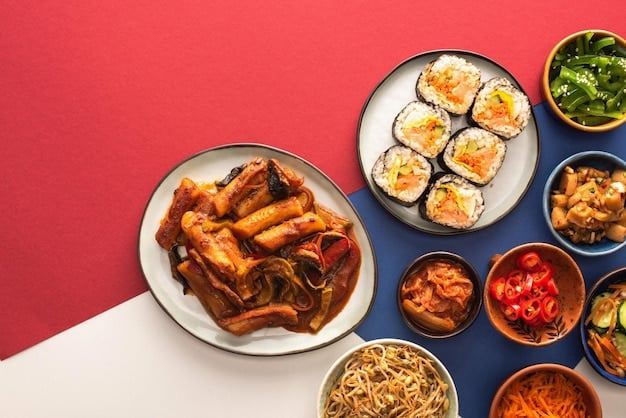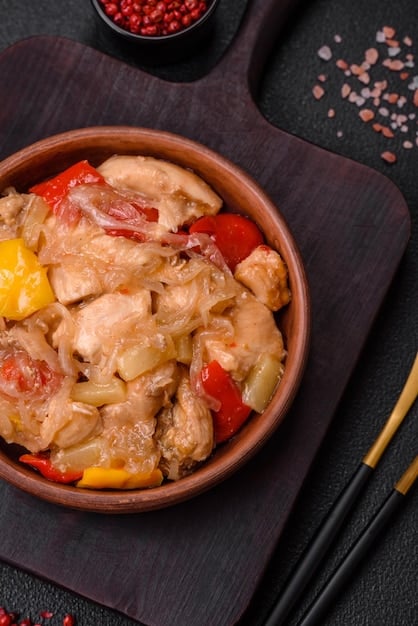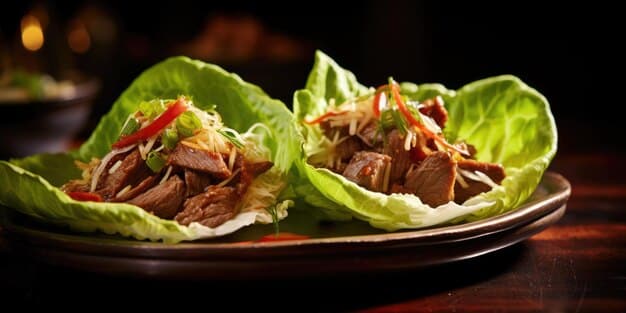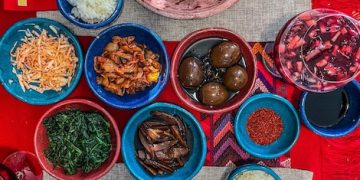Korean Cuisine Trends: What US Foodies Will Crave This Year

What’s New in Korean Cuisine Trends for US Foodies This Year? Expect a surge in regional specialties, plant-based Korean dishes, and innovative fusion concepts that blend traditional flavors with modern culinary techniques.
Get ready for a flavor explosion! What’s New in Korean Cuisine Trends for US Foodies This Year? From unexpected ingredients to exciting new takes on classics, the Korean food scene is about to get a whole lot more interesting.
Beyond Kimchi: Exploring Regional Korean Cuisine
Korean cuisine is far more diverse than many Americans realize. Beyond the well-known kimchi and bulgogi, a wealth of regional specialties are waiting to be discovered. This year, expect to see more restaurants and chefs showcasing these unique flavors.
Flavors of Jeolla Province
Jeolla province, known as the “granary of Korea,” boasts a culinary heritage rich in seafood, grains, and vegetables. Its dishes are often characterized by bold flavors and generous use of spices.
Busan’s Coastal Delights
From fresh seafood stews to street food snacks, Busan offers a taste of Korea’s coastal cuisine. Look out for restaurants specializing in Busan-style dishes this year.
- Sannakji (Live Octopus): Adventurous eaters can try sannakji, a Busan specialty featuring freshly cut octopus seasoned with sesame oil.
- Dwaeji Gukbap (Pork Rice Soup): A hearty and flavorful pork broth served with rice, a Busan staple.
- Eomuk (Fish Cakes): Busan is famous for its eomuk, available in various shapes and flavors.

Exploring the diverse regional cuisines of Korea offers a deeper appreciation for its culinary heritage. From the bold flavors of Jeolla to the coastal delights of Busan, there’s always something new to discover.
Plant-Based Korean Cuisine: A Rising Trend
With the growing popularity of vegan and vegetarian diets in the US, plant-based Korean cuisine is gaining traction. Chefs are reimagining traditional dishes using innovative ingredients and techniques.
Vegan Kimchi Variations
Traditional kimchi often contains fish sauce, but many restaurants now offer vegan versions using ingredients like seaweed or mushrooms for umami flavor.
Innovative Tofu Dishes
Tofu, a staple in Korean cuisine, is being used in creative ways to create satisfying and flavorful plant-based dishes.
- Tofu Steak: Thick slices of tofu marinated and grilled to perfection.
- Tofu Bibimbap: Bibimbap with seasoned tofu instead of meat.
- Vegan Japchae: Glass noodles stir-fried with vegetables and tofu.
Plant-based Korean cuisine is not just about replicating meat dishes; it’s about celebrating the versatility of vegetables and exploring new flavor combinations. This trend is expected to continue its rise in popularity as more consumers seek out healthy and sustainable food options.
Korean Fusion: Blending Tradition with Modernity
Korean cuisine is known for its adaptability, leading to exciting fusion concepts that blend traditional flavors with modern culinary techniques. This year, expect to see more innovative and creative Korean fusion dishes on US menus.
Korean Tacos
Korean-style marinated meats served in tacos with kimchi slaw and gochujang mayo, a popular fusion dish.
Kimchi Fried Rice Pizza
A creative twist on two comfort food classics, combining kimchi fried rice with pizza toppings.

- Gochujang Chicken Wings: Crispy chicken wings glazed with a sweet and spicy gochujang sauce.
- Bulgogi Burgers: Juicy burgers topped with marinated bulgogi beef and Korean-inspired toppings.
- Kimchi Quesadillas: A fusion of Korean and Mexican flavors with kimchi, cheese, and your choice of fillings in a grilled quesadilla.
Korean fusion cuisine offers a playful and exciting way to experience Korean flavors in familiar formats. This trend appeals to a wide audience, from adventurous foodies to those new to Korean cuisine.
The Rise of Korean Street Food in the US
Korean street food is becoming increasingly popular in the US, with food trucks and pop-up stalls offering a taste of Korea’s vibrant culinary scene. This trend is bringing authentic and affordable Korean flavors to a wider audience.
Tteokbokki (Spicy Rice Cakes)
Chewy rice cakes simmered in a spicy gochujang sauce, a classic Korean street food snack.
Hotteok (Sweet Pancakes)
Sweet pancakes filled with brown sugar, cinnamon, and nuts, a popular dessert street food.
Bungeoppang (Fish-Shaped Pastry)
A fish-shaped pastry filled with sweet red bean paste, a beloved Korean street food treat.
Korean street food offers a quick, affordable, and delicious way to experience Korean cuisine. Its increasing popularity in the US reflects a growing appreciation for authentic and flavorful food experiences.
DIY Korean Cooking Kits and Meal Delivery Services
For those who want to try their hand at Korean cooking at home, DIY kits and meal delivery services are becoming increasingly popular. These services provide pre-portioned ingredients and easy-to-follow recipes, making Korean cuisine accessible to everyone.
Kimchi Making Kits
DIY kits that provide all the ingredients and instructions needed to make kimchi at home.
Bibimbap Meal Kits
Meal kits that include pre-cooked rice, seasoned vegetables, and protein options for making bibimbap.
Korean BBQ Delivery
Services that deliver marinated meats and side dishes for a Korean BBQ experience at home.
DIY Korean cooking kits and meal delivery services make it easier than ever to enjoy Korean cuisine at home. This trend caters to busy consumers who want to experience authentic flavors without the hassle of grocery shopping and meal prep.
Korean Desserts: Sweet Endings to Explore
No culinary journey is complete without dessert. Korean desserts are often less sweet than their Western counterparts, showcasing unique flavors and textures. This year, explore the delightful world of Korean sweets.
Bingsu (Shaved Ice)
A popular Korean shaved ice dessert topped with sweet toppings like fruit, red bean paste, and condensed milk.
Yakgwa (Honey Cookie)
A traditional Korean honey cookie with a chewy texture and a subtle sweetness.
- Hwajeon (Flower Pancakes): Small, sweet pancakes adorned with edible flowers.
- Dasik (Tea Cookies): Decorative cookies made from rice flour, nuts, and herbs.
- Yaksik (Sweet Rice): Sweet rice mixed with nuts, jujubes, and honey.
Korean desserts offer a refreshing and satisfying end to any meal. From the refreshing bingsu to the delicate yakgwa, these sweet treats provide a unique glimpse into Korean culinary traditions.
| Key Trend | Brief Description |
|---|---|
| 🌏 Regional Cuisine | Exploring diverse flavors beyond mainstream Korean dishes. |
| 🌱 Plant-Based Options | Vegan kimchi, tofu dishes, and innovative recipes. |
| 🍔 Korean Fusion | Tacos, pizzas, and burgers with Korean flavors. |
| 🍢 Street Food Popularity | Tteokbokki, hotteok, and bungeoppang gaining traction. |
FAQ
▼
Some popular regional dishes include Andong Jjimdak from Andong, Dwaeji Gukbap from Busan, and dishes featuring fresh seafood from coastal regions.
▼
Examples include vegan kimchi variations, tofu bibimbap, and vegan japchae. These dishes often use plant-based substitutes for meat and fish sauce.
▼
Korean fusion cuisine blends traditional Korean flavors with international dishes, creating unique and innovative culinary experiences. Examples include Korean tacos and kimchi fried rice pizza.
▼
Korean street food can often be found at food trucks, pop-up stalls, and some Korean restaurants. Look for dishes like tteokbokki and hotteok.
▼
Popular Korean desserts include bingsu (shaved ice), yakgwa (honey cookie), and hwajeon (flower pancakes). These desserts are often less sweet than Western desserts.
Conclusion
As What’s New in Korean Cuisine Trends for US Foodies This Year? unfolds, American palates can anticipate a delightful exploration of regional specialties, innovative plant-based options, exciting fusion concepts, and the growing accessibility of Korean street food and home cooking solutions. The rich tapestry of Korean culinary traditions is set to captivate and inspire US food enthusiasts in the year ahead.





